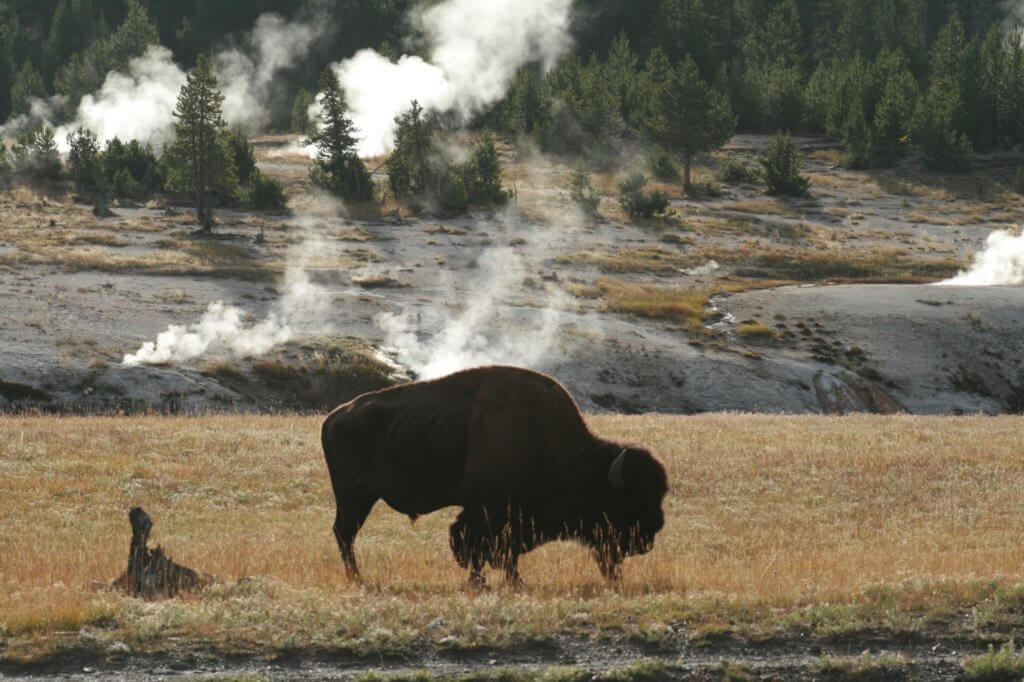Hunting Bison in the Place of Smokey Land
by Aspen Decker
Broadcast 11.2021 and 11.22 & 11.25.2023

Photo by Jean Beaufort, public domain.
Listen:
Near Čmʔomʔotúlexʷ (Place of Smokey Land) or Yellowstone National Park, in -5-degree weather, I kneeled on my freshly skinned bison hide, which provided steaming warmth beneath me. By the time I began skinning the bison it was dark. I looked up into the starry night and a flood of emotions came over me as I thought about my T̓at̓áyaqn (Bitterroot Salish) ancestors who hunted this way for thousands of years. All of a sudden, snčlčlép (coyotes) began howling and I felt this strong connection to my ancestors and the bison. This hunt helped me realize the sacred significance of bison to my people and I wanted to find out more about these glorious animals.
Bison are one of the largest animals in North America. The male bison can grow as tall as six feet and can weigh up to 2,000 pounds. The females can grow up to 5 feet tall and may weigh over 1,000 pounds. Bison can jump high fences and run up to 35 miles per hour. The average lifespan for a bison is 15-20 years old.
T̓at̓áyaqn ventured to the plains yearly to hunt q̓ʷiq̓ʷay (bison). The q̓ʷiq̓ʷay were the main source of food for the Salish people as well as a basis for shelter, clothing, and tools. The Salish believe that all parts of the q̓ʷiq̓ʷay should be used and not wasted.
Both the Salish and Blackfeet made a claim to the hunting grounds east of the Continental Divide. Typically, the Salish people would team up with other tribes like the Nez Perce or other Salishan tribes to have a better chance against the Blackfeet.
The Salish people had a couple of methods for hunting the q̓ʷiq̓ʷay. Sometimes they would dress up in bison hides to sneak into the herd. Other times they would hunt q̓ʷiq̓ʷay by horseback. The preferred method, however, was the buffalo jump, where hunters drove the bison herd over a cliff. The q̓ʷiq̓ʷay that did not die after the fall would be killed by the women with warclubs. The women also processed the q̓ʷiq̓ʷay hides and meat. The q̓ʷiq̓ʷay have to be skinned right after they are killed or else the meat spoils quickly. Q̓ʷiq̓ʷay brains were used to soften the hides while they were tanned. The meat was cut into thin slices and put on a dry meat rack that had a dim, smokey fire beneath it. The dried meat was then stored away for the winter.
In the late 1800s bison became scarce after the deliberate extermination campaign by the United States government. During that time the T̓at̓ayáqn had their last q̓ʷiq̓ʷay hunt, with only killing 7 bison. It wasn’t until the 1870s that ʔAtatíc̓eʔ (Falcon Robe) had a vision to bring the q̓ʷiq̓ʷay to the Flathead reservation. The chief at that time did not want to domesticate the q̓ʷiq̓ʷay. ʔAtatíc̓eʔ’s son Łatatí (Little Falcon Robe) was the one to bring his father’s vision to life. Łatatí brought back six orphaned q̓ʷiq̓ʷay calves to the Flathead reservation from the Plains. These q̓ʷiq̓ʷay grew into the largest herd in North America. Sadly, the Allotment Act of 1904 split up the land and opened up the Flathead Indian Reservation to White settlers. The Salish were forced to sell their q̓ʷiq̓ʷay herd to create space for the settlers. The herd was sold to a man in Kalispell, then later to the United States government, and, in 1908, they became the first q̓ʷiq̓ʷay to populate the National Bison Range. In 2020, the ownership of the Bison Range was restored to the Confederated Salish and Kootenai Tribes. Today, the National Bison Range is home to 350 to 500 q̓ʷiq̓ʷay, with 2,300 to 5,500 more living in and around Yellowstone National Park.
In 2006, after 100 years of oppression, T̓at̓áyaqn and other local tribes were finally able to travel to their aboriginal hunting grounds near Yellowstone to hunt bison. My first bison hunt was a life-changing experience that helped me connect to the “old ways” that had been absent for so long. Now, once again, it has become a vibrant part of our Salish hunting stories that can be taught to our children for generations to come.
Every week since 1991, Field Notes has inquired about Montana’s natural history. Field Notes are written by naturalists, students, and listeners about the puzzle-tree bark, eagle talons, woolly aphids, and giant puffballs of Western, Central and Southwestern Montana and aired weekly on Montana Public Radio.
Click here to read and listen to more Field Notes. Field Notes is available as a podcast! Subscribe on Apple Podcasts or wherever you listen to podcasts.
Interested in writing a Field Note? Contact Allison De Jong, Field Notes editor, at adejong [at] montananaturalist [dot] org or 406.327.0405.
Want to learn more about our programs as well as fun natural history facts and seasonal phenology? Sign up for our e-newsletter! You can also become a member and get discounts on our programs as well as free reciprocal admission to 300+ science centers in North America!












